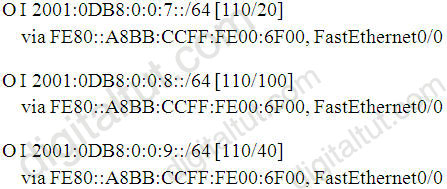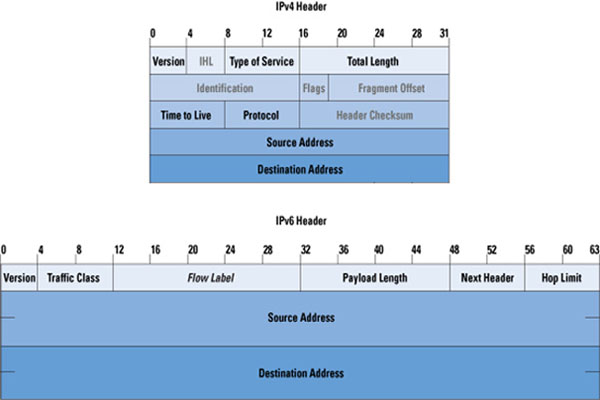IPv6 Questions 2
Here you will find answer to IPv6 Questions – Part 2
Question 1
Refer to the exhibit. In the show ipv6 route output, what would the metric be for a summary route that summarizes all three OSPFv3 routes displayed?

A. 20
B. 40
C. 100
D. 120
E. 140
F. 160
Answer: C
Explanation
The metric of a summary route is the highest cost of the routes being summarized. Therefore when summarizing three routes above the highest cost (100) will be chosen.
Question 2
Which statement is true concerning 6to4 tunneling?
A. IPv4 traffic is encapsulated with an IPv6 header.
B. The edge routers can use any locally configured IPv6 address.
C. Hosts and routers inside a 6to4 site will need a special code.
D. An edge router must use IPv6 address of 2002: :/16 in its prefix.
Answer: D
Explanation
6to4 tunnels use IPv6 addresses that concatenate 2002::/16 with the 32-bit IPv4 address of the edge router, creating a 48-bit prefix.
Question 3
Which two statements are true about using IPv4 and IPv6 simultaneously on a network segment? (Choose two)
A. Hosts can be configured to receive both IPv4 and IPv6 addresses via DHCP.
B. Host configuration: options for IPv4 can be either statically assigned or assigned via DHCP. Host configuration: options for IPv6 can be statically assigned only.
C. IPv6 allows a host to create its own IPv6 address that will allow it to communicate to other devices on a network configured via DHCP. IPv4 does not provide a similar capability for hosts.
D. IPv4 and IPv6 addresses can be simultaneously assigned to a host but not to a router interface.
E. IPv6 provides for more host IP addresses but IPv4 provides for more network addresses.
Answer: A C
Question 4
Which statement describes the difference between a manually configured IPv6 in IPv4 tunnel versus an automatic 6to4 tunnel?
A. A manually configured IPv6 in IPv4 tunnel allows multiple IPv4 destinations.
B. An automatic 6to4 tunnel allows multiple IPv4 destinations.
C. A manually configured IPv6 in IPv4 tunnel does not require dual-stack (IPv4 and IPv6) routers at the tunnel endpoints.
D. An automatic 6to4 tunnel does not require dual-stack (IPv4 and IPv6) routers at the tunnel endpoints.
Answer: B
Explanation
An automatic 6to4 tunnel allows isolated IPv6 domains to be connected over an IPv4 network to remote IPv6 networks. The key difference between automatic 6to4 tunnels and manually configured tunnels is that the tunnel is not point-to-point; it is point-to-multipoint -> it allows multiple IPv4 destinations -> B is correct.
A is not correct because manually 6to4 is point-to-point -> only allows one IPv4 destination.
Configuring 6to4 (manually and automatic) requires dual-stack routers (which supports both IPv4 & IPv6) at the tunnel endpoints because they are border routers between IPv4 & IPv6 networks.
Question 5
You need to explain the differences between an IPv4 header and an IPv6 header. In this comparison, which three statements are true? (Choose three)
A. An IPv6 header is half the size of an IPv4 header.
B. An IPv4 header includes a checksum. However, an IPv6 header does not include one.
C. A router has to recompute the checksum of an IPv6 packet when decrementing the TTL.
D. An IPv6 header is simpler and more efficient than an IPv4 header.
E. The 128-bit IPv6 address makes the IPv6 header more complicated than an IPv4 header.
F. An IPv6 header has twice as many octets as an IPv4 header.
Answer: B D F
Explanation
The image below shows the differences between an IPv4 header and an IPv6 header:

(Reference and a good resource, too: http://www.cisco.com/web/about/ac123/ac147/archived_issues/ipj_9-3/ipv6_internals.html)
Question 6
What are two rules for compacting IPv6 addresses? (Choose two)
A. The maximum number of times a double colon can replace a 16-bit segment that consists of all zeroes is two.
B. The leading zeroes in any 16-bit segment do not have to be written.
C. Every 16-bit segment that consists of all zeroes can be represented with a single colon.
D. The trailing zeroes in any 16-bit segment do not have to be written.
E. Any single, continuous string of one or more 16-bit segments that consists of all zeroes can be represented with a double colon.
F. Two zeroes in the middle of any 16-bit segment do not have to be written.
Answer: B E
Explanation
These rules are very popular for compacting IPv6 addresses, if you are not sure about them please read my IPv6 tutorial.
Question 7
How is authentication handled with OSPFv3?
A. OSPFv3 for IPv6 authentication is supported by SHA-1 authentication.
B. OSPFv3 for IPv6 authentication is supported by MD5 authentication.
C. OSPFv3 for IPv6 authentication is supported by IPv6 IPsec.
D. OSPFv3 for IPv6 authentication is supported by IPv4 IPsec.
Answer: C
Question 8
sing the rules for IPv6 addressing, how can the address 2031:0000:240F:0000:0000:09C0:123A:121B be rewritten?
A. 2031:0:240F::09C0:123A:121B
B. 2031::240F::09C0:123A:121B
C. 2031::240F::9C0::123A:121B
D. 2031::240F:::09C0:123A:121B
Answer: A
Question 9
Refer to the exhibit. What is required to complete the IPv6 routing configurations shown?
| Router1# interface S1/1 ipv6 address 2001:410:FFFF:1::1/64 ipv6 ospf 100 area 0 interface S2/0 ipv6 router ospf 100 Router2# ipv6 router ospf 100 |
A. Interface authentication must be configured.
B. The routing processes must be configured with an area ID.
C. IP unicast routing must be enabled.
D. IPv4 addresses must be applied to the interfaces.
Answer: C
Question 10
When implementing OSPFv3, which statement describes the configuration of OSPF areas?
A. In interface configuration mode, the OSPFv3 area ID combination assigns interfaces to OSPFv3 areas.
B. In router configuration mode, the network wildcard area ID combination assigns networks to OSPFv3 areas.
C. In interface configuration mode, the IPv6 OSPF process area ID combination assigns interfaces to OSPFv3 areas.
D. In router configuration mode, the IPv6 OSPF interface area ID combination assigns interfaces to OSPFv3 areas.
Answer: C


